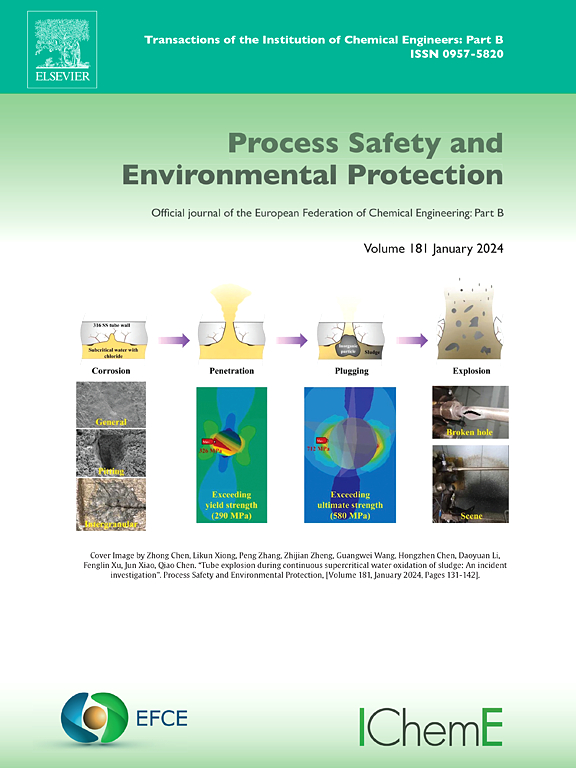化学发泡剂和矿物发泡剂对泡沫充填体膨胀、保温、强度特性和微观结构的影响
IF 6.9
2区 环境科学与生态学
Q1 ENGINEERING, CHEMICAL
引用次数: 0
摘要
泡沫由大量气泡组成,形成不安全的体系,有效地用于胶结材料,包括胶结尾砂回填体(CTB)。泡沫ctb (FCTB)保留了密度小、导热系数小、和易性高、耐火性好的优点。然而,FCTB的行为受其独特的微观结构支配,这在很大程度上取决于矿山充填体所用泡沫材料的类型和特征。本研究以尾矿、发泡剂(FA)和水泥为原料,制备了一种新型的膨胀保温型FCTB。通过膨胀试验、单轴压缩、导热系数测量以及XRD、FTIR和SEM-EDS分析,研究了FCTB的膨胀特性、强度、保温性能和微观结构的影响。实验室结果证明,加入三种不同的FA(即SDS:十二烷基硫酸钠,阴离子表面活性剂;ADC:偶氮二甲酰胺,化学发泡剂;DTAB:阳离子表面活性剂十二烷基三甲基溴化铵)显著提高了浆料的膨胀率,DTAB-0.8提高了14.6 %。随着FA添加量的增加,FCTB的UCS整体下降,但在FA添加量为0.2 %时,ADC和DTAB的强度分别提高了45.15 %和28.21 %。同时,FA有针对性地提高了FCTB的峰值应变,增强了其延性。FA的加入也显著降低了FCTB的导热系数。DTAB含量为0.8 %时,填料的导热系数降至0.5726 W/(m·K),增强了填料的保温能力。FA也促进了水化产率的形成。随着FA含量的增加,孔隙率增加,水化产率粘附在填料表面。FCTB具有优良的导热性能和强度性能,为尾砂等固体废弃物资源化利用提供了新思路,为开发高效填充型保温材料提供了潜在的技术途径。本文章由计算机程序翻译,如有差异,请以英文原文为准。
Effect of chemical and mineral foaming agents on expansion, insulation, strength features, and microstructure of foam backfill
Composed of large numbers of bubbles, foam creates an insecure system and is efficiently used in cementitious materials, including cemented tailings backfill (CTB). Foam-CTB (FCTB) retains some benefits of little density/thermal conductivity, and high workability/fire resistance. However, the behavior of FCTB is governed by its unique microstructure, which heavily relies on types and features of the foam used in mine fill. In this study, a novel arrangement of expansion and thermal insulation-based FCTB was created by tailings, foaming agents (FA) and cement as raw material. The study investigated the effects of expansion features, strength, thermal insulation and microstructure of FCTB using expansion tests, uniaxial compression, thermal conductivity measurements, and analyses via XRD, FTIR, and SEM-EDS. Lab findings certify that adding three diverse FA (i.e., SDS: sodium dodecyl sulphate, anionic surfactant; ADC: azodicarbonamide, chemical foaming agent; and DTAB: dodecyl trimethyl ammonium bromide, cationic surfactant) significantly increased the expansion rate of slurry, and DTAB-0.8 increased by 14.6 %. By rising FA dosage, UCS of FCTB dwindled as a whole, but the strength of ADC and DTAB increased by 45.15 % and 28.21 % respectively at 0.2 % content. In chorus, FA pointedly improved FCTB’s peak strain, enhancing its ductility. Addition of FA also significantly diminished FCTB’s thermal conductivity. As content of DTAB was 0.8 %, thermal conductivity dropped to 0.5726 W/(m·K), enriching fill’s thermal insulation ability. FA also promoted the formation of hydration yields. By rising FA content, porosity increased, and hydration yields adhered to fill surface. FCTB has superb thermal conductivity and strength properties, which afford a novel idea for source use of solid waste such as tailings, and provide a potential technical way for the development of efficient filling thermal insulation materials.
求助全文
通过发布文献求助,成功后即可免费获取论文全文。
去求助
来源期刊

Process Safety and Environmental Protection
环境科学-工程:化工
CiteScore
11.40
自引率
15.40%
发文量
929
审稿时长
8.0 months
期刊介绍:
The Process Safety and Environmental Protection (PSEP) journal is a leading international publication that focuses on the publication of high-quality, original research papers in the field of engineering, specifically those related to the safety of industrial processes and environmental protection. The journal encourages submissions that present new developments in safety and environmental aspects, particularly those that show how research findings can be applied in process engineering design and practice.
PSEP is particularly interested in research that brings fresh perspectives to established engineering principles, identifies unsolved problems, or suggests directions for future research. The journal also values contributions that push the boundaries of traditional engineering and welcomes multidisciplinary papers.
PSEP's articles are abstracted and indexed by a range of databases and services, which helps to ensure that the journal's research is accessible and recognized in the academic and professional communities. These databases include ANTE, Chemical Abstracts, Chemical Hazards in Industry, Current Contents, Elsevier Engineering Information database, Pascal Francis, Web of Science, Scopus, Engineering Information Database EnCompass LIT (Elsevier), and INSPEC. This wide coverage facilitates the dissemination of the journal's content to a global audience interested in process safety and environmental engineering.
 求助内容:
求助内容: 应助结果提醒方式:
应助结果提醒方式:


